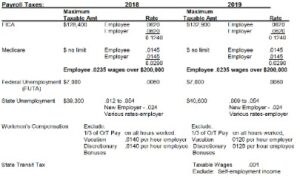
Even somewhat repeatable projects require modifications due to site conditions and other factors. Construction business involves very different challenges than other kinds of production. Most of these challenges arise from the fact that construction is how do you calculate the payroll accrual project-based, and each project involves unique problems and solutions.
Likewise, revenue is recognized when the contractor meets a performance obligation by transferring goods or services to the customer for a fee. As there must be something to it, let’s examine each principle closely — and then get into the 3 foundational pillars of construction accounting. On this difficult path, construction accountants need all the help they can get.
- With its intuitive interface and powerful features, PlanSwift has become a valuable tool for construction professionals.
- You are also going to record the earned revenue and any expenses during each stage.
- Janet Berry-Johnson, CPA, is a freelance writer with over a decade of experience working on both the tax and audit sides of an accounting firm.
- Having the right bookkeeping expertise builds a solid foundation for accurate financial management and informed decision-making in your construction business.
- Construction accountants work closely with project managers and other team members to ensure that financial decisions are made in the best interest of the project.
Tip #3: Use a time-tracking and scheduling tool to oversee activities
For example, accurate job costing can help a company identify where it makes or loses money and respond quickly before it negatively impacts profitability. Efficient construction accounting and accurate bookkeeping are essential parameters in the construction industry. However, although construction accounting is built on standard accounting principles, it is a specialty due to construction companies’ unique way of working. When accounting for job costs, keeping track of the different expenses by project is essential.
In summary, job costing mechanics in construction accounting involve strategizing and tracking project expenses by separating them into direct and indirect costs. Accurate reporting plays a pivotal role in effective job costing, facilitating informed decision-making and resource allocation across projects. Companies can use construction accounting software like QuickBooks to effectively track and report job costs, job costing definition enhancing cost management and overall project success. Construction accounting is a specialized branch of accounting that caters specifically to the unique financial and operational needs of the construction industry. It addresses the distinct challenges presented by construction projects, such as long-term timelines, complex costing structures, and contractual obligations.
This can be achieved through various methods such as physical completion, units of work completed, or cost-to-cost ratio. The chosen method should accurately reflect the actual progress of the project to ensure the integrity of the financial statements. Under this method, revenue and expenses are recognized proportionally as the project progresses. This means that if a construction project is 50% complete, 50% of the estimated revenue and expenses are recognized in the financial statements. This allows for a more accurate reflection of the project’s profitability and financial position at any given point in time. Another key term in construction accounting is “retention.” Retention refers to a portion of the contract price that is withheld by the client or owner until the completion of the project.

This means that revenue auction definition is recognized as the project progresses and reaches certain milestones. Besides debits, credits, and financial statements, contractors have many additional aspects that need to be managed and accounted for. Job costing helps you track many variables in your project-centric decentralized business. Applying construction accounting best practices can bring benefits to your entire organization.
Features of construction accounting and invoices
The percentage of completion method has numerous advantages for companies that are balancing several long-term projects. Most importantly, this method enables financial managers to get a clear view of the current financial status of each project as well as the financial horizon as each project progresses. An accountant will help you make sense of the numbers, manage your books, generate reports, estimate your quarterly tax payments, maintain a healthy cash flow, and protect narrow profit margins. For beginners, construction accounting for dummies books offer an easy-to-understand introduction to the field. These books break down complex concepts into simpler terms, making it easier for those new to the industry or accounting to grasp the basics.
Keeping track of all these costs helps account for them in a way that ensures the company is making enough money on each project to cover its expenses and make a decent profit for the owners. In the construction industry, the most common and useful method of accounting is the percentage of completion method. This approach involves billing costs as a proportion of how complete the project is, allowing for the balanced distribution of costs and expenses throughout the project’s lifespan. Construction accounting is different from standard accounting as it deals with long-term projects that have uncertain results, changing costs, and complex contracts. On the other hand, standard accounting is about short-term deals, simple contracts, and set prices.
Accrual method
As such, accurate job costing involves a categorical allocation of costs, distinguishing between direct expenses like labor and materials and indirect overheads. The insights gleaned from job costing empower contractors to maintain budgetary constraints, gauge project profitability, and anticipate potential financial challenges. Use a journal, spreadsheets, or construction accounting software to record day-to-day transactions like accounts payable, accounts receivable, labor costs, and material costs incurred. You’ll want to include a description of each transaction, the date of the transaction, and the revenue received.
Its simplicity usually means lower construction accounting costs than accrual accounting, which provides a clear overview of the company’s actual cash position. To accurately estimate the expenses and incomes that can be incurred and earned in a job, you need to understand all aspects of its labor costs, material costs, and overhead costs. Fixed prices and point-of-sale charges are used in many industries but not always in construction.



